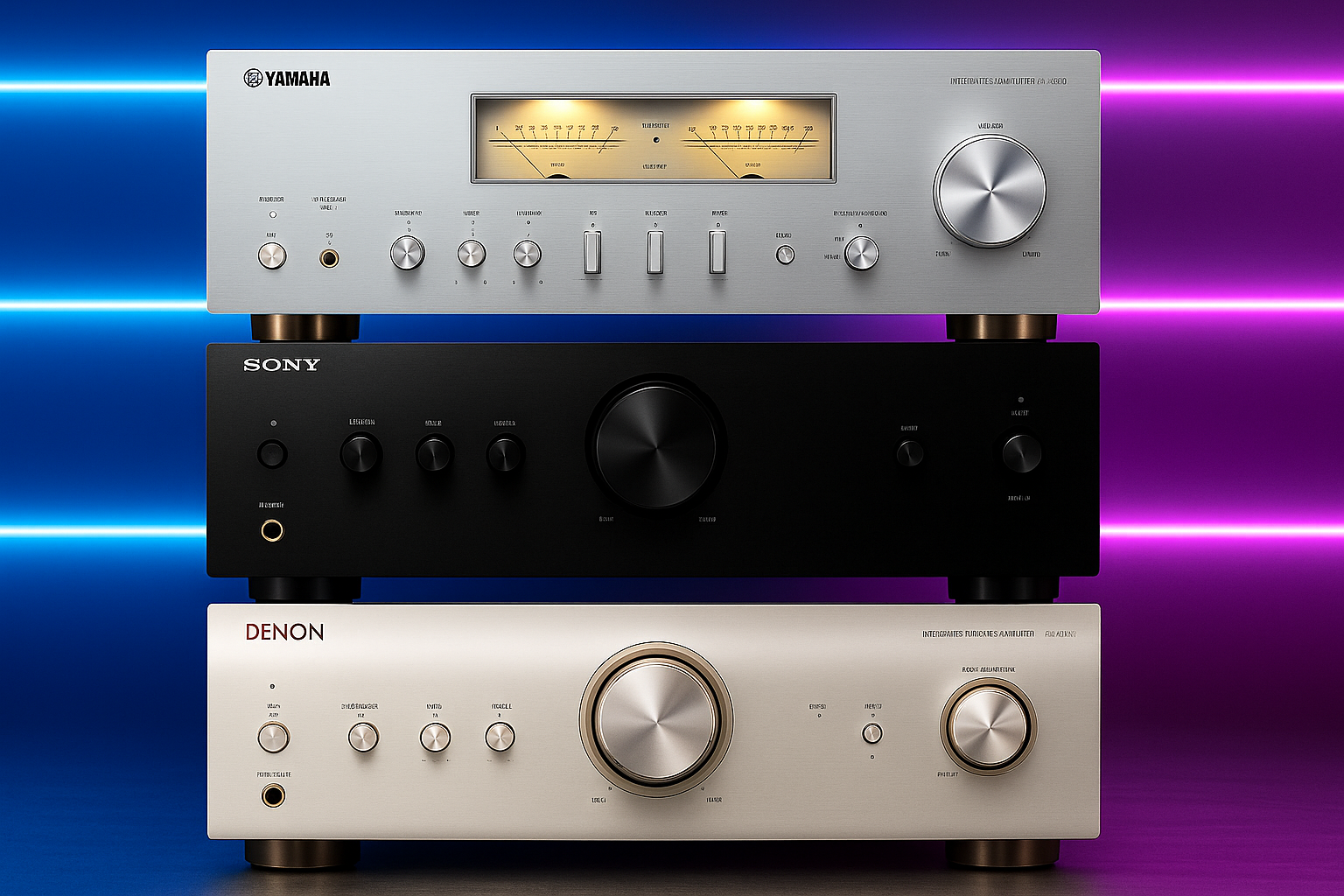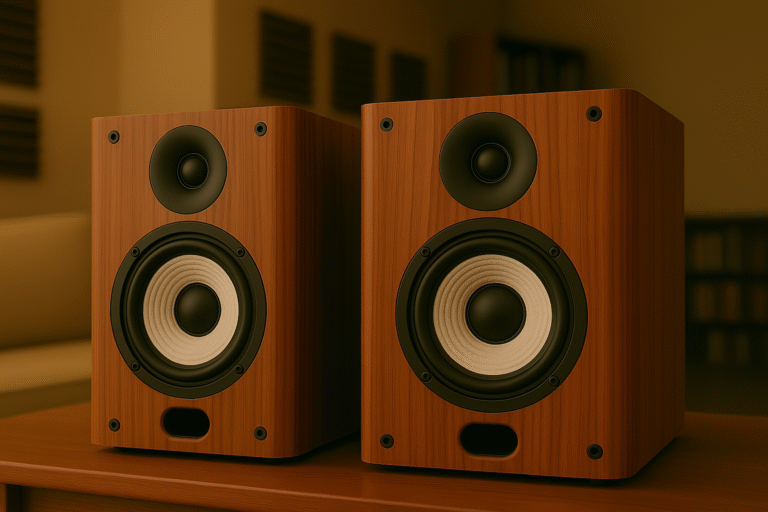🎧 The Amplifier: Where the Soul of Your Sound Is Born
If you are beginning to build your Hi-Fi system, or already have one and want to take it to the next level, a fundamental question will eventually arise:
What exactly does the amplifier do—and why are there so many types?
It’s perfectly normal to feel a bit lost. Integrated amplifiers, preamps, power amps, stereo receivers… the terminology can be overwhelming.
But don’t worry. In this guide, we will walk you through each option step by step, so that by the end, you will not only understand the differences—you will be able to make an informed decision with confidence.
Because once you truly grasp what a good amplifier contributes, it’s no longer just about volume.
It’s about character. About dynamics. About emotion.
🧠 What Does an Amplifier Actually Do?
In simple terms, an amplifier takes a low-level audio signal from a source (like a turntable, CD player, or streamer) and boosts it so your speakers can play it with clarity and power.
It is, quite literally, the heart of your system—pushing the signal so that your music can come to life.
However, not all amplifiers perform this role in the same way—or with the same results. That’s why it’s essential to understand the options.
🔍 Main Types of Hi-Fi Amplifiers Explained
🔹 Integrated Amplifier: Simplicity and Performance in One Box
This is the most common and straightforward choice. It includes both the preamplifier (for volume and input control) and the power amplifier (which drives the speakers) in a single unit.
Many modern models also include:
- Built-in DACs (for connecting TVs or computers)
- Bluetooth or Wi-Fi streaming
- Phono input for vinyl playback
✅ Ideal for those who want excellent sound quality with fewer cables and hassle.
🔹 Separates: Preamp + Power Amp for Ultimate Control
This setup separates the control section (preamplifier) from the power section (amplifier), allowing each part to be optimized individually.
While it requires more investment and space, it delivers higher fidelity, more headroom, and finer control over your system.
⚠️ Suitable for those seeking professional-level performance and customization.
🔹 Stereo Receivers: A Classic Experience with Modern Capabilities
Stereo receivers are similar to integrated amps but also include a built-in radio tuner (FM/AM or DAB+), making them perfect for users who still enjoy traditional broadcast radio.
✅ A great solution for those who want a touch of nostalgia without sacrificing sound quality.
🎵 Why All This Actually Matters
A good amplifier doesn’t just make your system sound louder.
It brings it to life.
It allows you to feel the music, not just hear it.
To notice textures, space, silence—and all the nuances that make a piece of music truly moving.
It can make your favorite recordings sound more open, natural, and real.
That’s why choosing the right amplifier matters. And in the next sections, we’ll show you exactly how to do it.
🔊 Why RMS Power Matters
RMS (Root Mean Square) power is the true, continuous power an amplifier can deliver—and the most honest figure you’ll see on a spec sheet.
Why is it important? Because matching your amplifier’s RMS output to your speakers’ RMS handling range is key to both performance and safety.
- An underpowered amplifier may clip (distort), sending harmful signals that can damage your speakers over time.
- An overpowered amplifier gives more “headroom” to handle sudden peaks in music without distortion, but you must use it responsibly.
- Remember: Watts ≠ Volume. More watts mean more dynamic control—not necessarily louder sound.
What to do: Always check the recommended RMS power range for your speakers, and ensure your amplifier falls comfortably within that window. It’s better to be slightly overpowered than underpowered—as long as you stay in control of the volume.
✅ See our speaker guide for more on matching RMS power:
Smart Buying Tips for Compact Hi-Fi Speakers
But RMS power is only part of the equation.
To truly understand what an amplifier is capable of, you must also look at a series of technical specifications that are always present in any power amplifier. These specs are like the amplifier’s DNA—they define how it behaves, what it excels at, and where its limitations lie.
Understanding them will help you evaluate performance more accurately, and choose a model that fits your needs—not just in theory, but in real-world listening.
🎛️ Understanding Key Amplifier Specifications
We know that spec sheets can sound like a foreign language. But each number tells a story—and understanding them can help you choose better.
Here’s what matters, why it matters, and how to interpret it.
-
1. Output Impedance & Load Stability
What is it? Speakers have resistance (impedance), measured in ohms (Ω). Some are 8Ω, others 4Ω. The lower the impedance, the more demanding the speaker.
Why it matters: If your amp isn’t designed to handle lower impedances, it might overheat or distort.
What to look for: Check that the amp is rated as “stable at 4 ohms” or lower.
-
2. Signal-to-Noise Ratio (SNR)
What is it? Measures the background noise vs. the actual music signal.
Why it matters: A higher SNR means less hiss or hum.
What to look for: Values over 90 dB are good; over 100 dB is excellent.
-
3. Total Harmonic Distortion (THD)
What is it? Shows how much distortion the amp adds.
Why it matters: Less distortion = clearer, smoother audio.
What to look for: Below 0.1% is good; 0.01% is high-fidelity level.
-
4. Frequency Response
What is it? Range of frequencies the amp can reproduce evenly.
Why it matters: Ensures natural, uncolored sound.
What to look for: 20 Hz – 20 kHz with ±0.5 dB variation or better.
-
5. Damping Factor
What is it? Measures control over speaker cone movement.
Why it matters: Higher damping = tighter, more defined bass.
What to look for: Over 100 is good; 300+ is excellent.
-
6. Input Sensitivity
What is it? Voltage needed by the amp to reach full output.
Why it matters: Ensures compatibility with your audio sources.
What to look for: Typically 0.5V to 2V; ensure phono input if using a turntable.
-
7. Crosstalk
What is it? Signal leakage between left and right channels.
Why it matters: Less crosstalk = better stereo image.
What to look for: –70 dB or lower is desirable.
-
8. Current Capability
What is it? The amp’s ability to deliver dynamic bursts of power.
Why it matters: Enables better control and punch with demanding speakers.
What to look for: Wattage should nearly double when impedance is halved (8Ω ➜ 4Ω).
Explore Amazon listings by region
As an Amazon Associate, I earn from qualifying purchases. Your support helps keep this site running.
🧠 Final Thoughts
A well-chosen amplifier defines your system’s character.
It doesn’t just amplify—it shapes the way you experience music.
And when it’s the right match for your speakers and listening style, it becomes more than just a component.
It becomes the engine of your musical experience.


